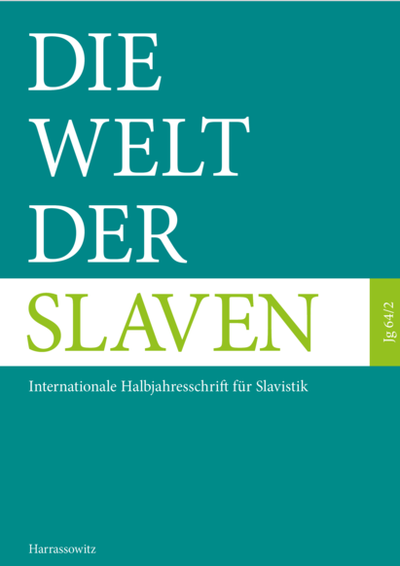On differences between homonymy and polysemy of Russian onomatopoeic verbal interjections
Abstract
In this article I investigate polysemy within the word class of onomatopoeic verbal interjections in Russian. The main aim of the study is to demonstrate on the basis of data from the Russian National Corpus that these linguistic units combine sound-symbolic, interjectional and predicative features. Secondly, this research analyses cases of homonymy between onomatopoeic verbal interjections and other grammatical classes. It considers cues on the basis of which the linguistic units in question can be identified and classified as belonging to a certain class of words. Finally, this article considers factors that have caused both homonymy and polysemy to be typical of one and the same group of words such as Russian onomatopoeic verbal interjections.
Literaturhinweise
Ameka, F.K. 1992. Interjections: The universal yet neglected part of speech. Journal of Pragmatics 18(2/3), 101–118.
Cuenca, M.J. 2000. Defining the indefinable? Interjections. Syntaxis 3, 29-44.
Efremova, T.F. 2006. Sovremennyj tolkovyj slovar′ russkogo jazyka: v trex tomax. Moskva.
Hasada, R. 2001. Meanings of Japanese sound-symbolic emotion words. In: Harkins, J. & A. Wierzbicka (ed.). Emotions in Crosslinguistic Perspective. Berlin, 217–253.
Isačenko, A.V. 1975. Die russische Sprache der Gegenwart. München.
Karcevskij, S.O. 1984. Vvedenie v izučenie meždometij. Voprosy jazykoznanija 6, 127–137.
Kor Chahine, I. 2008. Pljux! → pljux → pljuxnutʹ(sja): K voprosu ob ėvoljucii narrativnyx predikativov v svete korpusnyx dannyx. Slavica Helsingiensia 34, 152–162.
Kryk, B. 1992. The pragmatics of interjections: The case of Polish no. Journal of Pragmatics 18, 193–207.
Lemaitre, G. 2011. Vocal imitations and the identification of sound events. Ecological Psychology 23(4), 267–307.
Martin, S.E. 1964. Speech levels in Japan and Korea. In: Hymes, D. (ed.). Language in culture and society: A reader in linguistics and anthropology. New York, 407–415.
Meinard, M.E.M. 2015. Distinguishing onomatopoeias from interjections. Journal of Pragmatics 76, 150–168.
Nikitina, T. 2012. Russian verboids: A case study in expressive vocabulary. Linguistics 50(2), 165–189.
Oswalt, R.L. 1994. Inanimate imitatives in English. In: Hinton, L., J. Nichols & J.J. Ohala (ed.). Sound Symbolism. Cambridge, 293–308.
Pharies, D.A. 1979. Sound symbolism in the Romance languages. Berkeley. (Unpublished doctoral dissertation.)
Rhodes, R. 1994. Aural images. In: Hinton, L., J. Nichols & J.J. Ohala (ed.). Sound Symbolism. Cambridge, 276–292.
Shibatani, M. 1990. The Languages of Japan. Cambridge.
Švedova, N.Ju. (ed.). 1980. Russkaja grammatika. Moskva.
Wierzbicka, A. 1991. Cross-cultural pragmatics: The semantics of human interaction. Berlin.
Wilkins, D.P. 1992. Interjections as deictics. Journal of Pragmatics 18, 119–158.
Waugh, L.R. & M. Newfield. 1995. Iconicity in the lexicon and its relevance for a theory of morphology. In: Landsberg, M.E. (ed.). Syntactic iconicity and linguistic freezes: The human dimension. Berlin, 189–222.
Zaliznjak, Аndrej А. 2010. Grammatičeskij slovar′ russkogo jazyka: Slovoizmenenie. Moskva.

